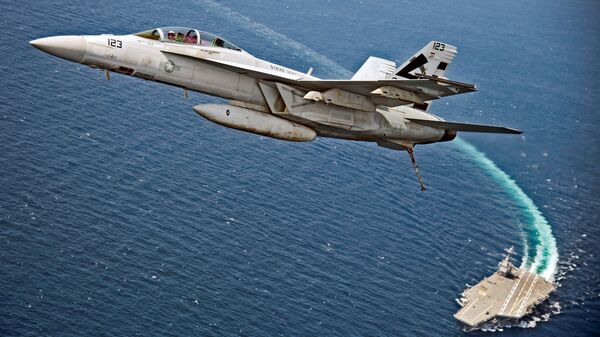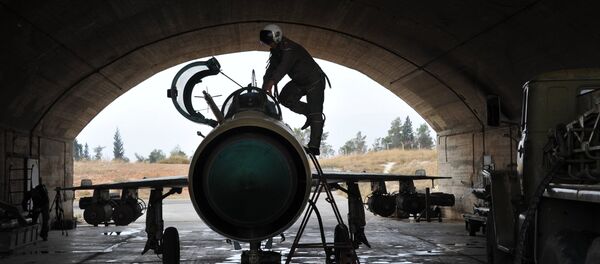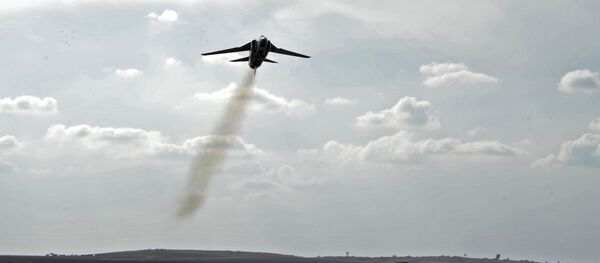The four pilots involved at the shoot down hosted a special panel during the Tailhook 2017 Symposium, an event meant to encourage camaraderie and fraternity between US naval aviators. They described the air battle between a US Navy F/A-18E Super Hornet and a Syrian Air Force Su-22 Fitter above Raqqa, Syria in great detail.
The pilots deployed from the aircraft carrier George W Bush, which had arrived in the Mediterranean Sea just days earlier. Pilot Lt. Cmdr. Michael "MOB" Tremel said that he and his wingman Lt. Cmdr. Jeff "Jo Jo" Krueger were on a mission of simple air support of US-allied Syrian Democratic Forces (SDF.)
"Everyone's kind of heading to the same place that day, to Raqqa," said Tremel. "At that point in time, the [area of responsibility] was pretty hot in that general vicinity and a lot of guys were dropping bombs."
Tremel and Krueger coordinated with two Hornet fighter jets that had also deployed from the Bush. They then noticed an Su-22 circling overhead. Tremel says their initial thought was that the plane was Russian Air Force, no uncommon sight in the skies of Syria.
Still, Tremel says, he decided to monitor the Su-22's activities. While he attempted to gain a visual ID on the aircraft, Krueger focused on the lines of communication. Soon the Super Hornet team realized that the plane wasn't Russian at all, but Syrian.
"Our whole mission out there was to defeat [Daesh], annihilate [Daesh]," Tremel said. "So as quickly as we can get back to that mission, that was our goal that day… At any point in time, if this had de-escalated, that would have been great. We would have gotten mission success and [gone] back to continue to drop bombs on [Daesh]."
As such, Tremel said, he sent multiple messages to the Su-22 that so long as it didn't threaten US-friendly forces, it would be left alone. But the Su-22 continued to approach SDF troops on the ground.
Tremel then said that he and Krueger conducted a series of "head-butts", a close overhead pass of the Su-22 with warning flares. These were meant to intimidate the Su-22 into turning around, but they had the opposite intended effect.
"After that third one, he [proceeded] to execute a dive and release ordnance in proximity of friendly forces," Tremel said.
As the Su-22 climbed, Tremel made the decision to fire an infrared-guided AIM-9X Sidewinder missile- but he missed. "I lose the smoke trail and I have no idea what happened to the missile at that point in time," Tremel said, describing the incident in real-time.
Immediately, Tremel fired a second missile: a radar-guided AIM-120 Advanced Medium-Range Air-to-Air Missile, or AMRAAM. This one hit. "The aircraft will pitch right and down and pilot will jump out and left in his ejection seat," he said, adding that he veered to the left to avoid the debris of the destroyed Syrian fighter.
In a previous interview, Tremel claimed that Krueger had seen the Syrian pilot eject to safety, but he had not.
Krueger called his copilot's decision "no small feat," as this was the first time since the Gulf War that a US naval aviator had shot down an armed aircraft. "Looking at the wreckage down below us, It was a different feeling," Krueger said. "… We had to make some decisions pretty quickly, and I thought that the training and commander's guidance that we got at that point was a big deal."
Tremel said that he and Krueger decided to return to the George W Bush. He praised Krueger and his fellow pilots, as he had done in previous statements. "I couldn't have done it without the guy sitting next to me, Jo Jo, and the other guys that were airborne. It was an absolute team effort, to include all the coordination that went on with the Air Force the entire time we were in [Syrian airspace]."






